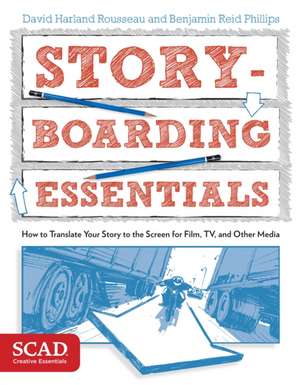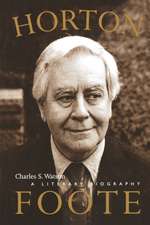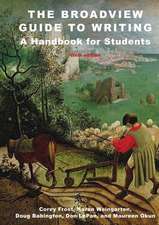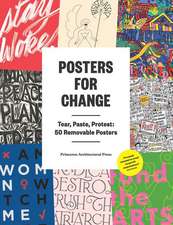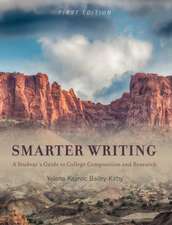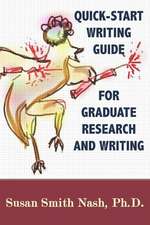Storyboarding Essentials: How to Translate Your Story to the Screen for Film, TV, and Other Media: SCAD Creative Essentials
Autor David Harland Rousseau, Benjamin Reid Phillipsen Limba Engleză Paperback – 31 iul 2013
Preț: 159.38 lei
Nou
Puncte Express: 239
Preț estimativ în valută:
30.50€ • 31.93$ • 25.23£
30.50€ • 31.93$ • 25.23£
Carte disponibilă
Livrare economică 17-31 martie
Preluare comenzi: 021 569.72.76
Specificații
ISBN-13: 9780770436940
ISBN-10: 0770436943
Pagini: 191
Ilustrații: full colour throughout, includes 30 photographs, includes 390 illustrations
Dimensiuni: 218 x 275 x 13 mm
Greutate: 0.79 kg
Editura: Watson-Guptill Publications
Seria SCAD Creative Essentials
ISBN-10: 0770436943
Pagini: 191
Ilustrații: full colour throughout, includes 30 photographs, includes 390 illustrations
Dimensiuni: 218 x 275 x 13 mm
Greutate: 0.79 kg
Editura: Watson-Guptill Publications
Seria SCAD Creative Essentials
Notă biografică
BENJAMIN REID PHILLIPS has been teaching drawing, storyboarding, and sequential art courses at SCAD since 2004. He is also a sequential artist and illustrator whose work has been featured in the Cartoon Art Museum's Monsters of Webcomics series. He won the Georgia College Press Association's Best Editorial Feature for his District serial, Dr. Dead. Phillips has also worked on Devil's Due comic edition of FOX's hit TV series, Family Guy.
DAVID HARLAND ROUSSEAU has taught drawing and design courses at SCAD since 2005. He is an entrepreneur, author, award-winning illustrator, graphic designer, actor, and former video journalist and news reporter. In 2008, he was named to the Business Report and Journal's "40 Under 40" list, and is the recipient of a Silver ADDY Award. He has also written Savannah Tavern Tales and Pub Review and Savannah Ghosts: Haunts of the Hostess City, illustrated by Julie Collins.
DAVID HARLAND ROUSSEAU has taught drawing and design courses at SCAD since 2005. He is an entrepreneur, author, award-winning illustrator, graphic designer, actor, and former video journalist and news reporter. In 2008, he was named to the Business Report and Journal's "40 Under 40" list, and is the recipient of a Silver ADDY Award. He has also written Savannah Tavern Tales and Pub Review and Savannah Ghosts: Haunts of the Hostess City, illustrated by Julie Collins.
Extras
Regardless of genre or discipline, storyboards share a language that reflects the jargon and terminology employed by industries born out of the filmed visual narrative. They connect written word to final cut; they concern themselves with what the camera “sees” (framing height, camera angle, and movement); they use standard and recognized formats (aspect ratios); and they even employ similar organizational systems (numbering). While the cinematographer relies on instinct and experience, a good storyboard artist will develop a strong understanding of camera angles and framing heights to help the director achieve his or her vision.
Cuprins
Contents
Foreword, by Stratton Leopold
Introduction
1. What Is Storyboarding?
The Types of Storyboards
A Visual Road Map
2. Interpreting the Written Word
Script Basics
Script Breakdowns
Spec Scripts Versus Shooting Scripts
“And Now, a Word from Our Sponsor”
Exercise: Script Breakdowns and Thumbnails
A Difference of Opinion: The Great Savannah Race
Interview: Kenny Chaplin, DGA/DGC
3. Rendering
Rough or Polished Finish
Little Drawings, Big Ideas
The Right Tool for the Job
Compositing
A Difference of Opinion: Un-Deadwood
Interview: Keith Ingham
4. Principles, Elements, and Conventions
Aspect Ratios
Getting Started
Blocking the Composition
Staying Organized
Numbering
How to Insert Shots
Exercise: Numbering
5. Continuity
What Is Continuity?
Axis and Allies
Breaking the Axis
30 Degrees of Separation
Neutralizing and Cutaway Shots
Screen Direction and Visual Logic
Avoiding Confusion
Building Tension and Creating a Surprise
Don’t Turn Around
A Difference of Opinion: Hyde from Jekyll—the Chase
6. What the Camera Sees
The Camera
Deep and Wide
Shooting on Location
Framing Heights and Angles
Other Shots to Consider
Cut to the Chase
Behind the Scenes
Exercise: Identifying Framing Heights and Angles
7. Move Me!
No Reaction Without “Action!”
Movements
Drawings Versus Diagrams
Camera Moves as Drawings
Photomatics and Digimatics
Order Out of Chaos
Exercise: Movement Calls
A Difference of Opinion: Hyde from Jekyll—Transmogrification
Interview: Whitney Cogar
8. The Martini Shot
Putting It All Together
A Toast to Storyboarding
Afterword: Humans Tell Stories, by Tina O’Hailey
Appendix
Index
Foreword, by Stratton Leopold
Introduction
1. What Is Storyboarding?
The Types of Storyboards
A Visual Road Map
2. Interpreting the Written Word
Script Basics
Script Breakdowns
Spec Scripts Versus Shooting Scripts
“And Now, a Word from Our Sponsor”
Exercise: Script Breakdowns and Thumbnails
A Difference of Opinion: The Great Savannah Race
Interview: Kenny Chaplin, DGA/DGC
3. Rendering
Rough or Polished Finish
Little Drawings, Big Ideas
The Right Tool for the Job
Compositing
A Difference of Opinion: Un-Deadwood
Interview: Keith Ingham
4. Principles, Elements, and Conventions
Aspect Ratios
Getting Started
Blocking the Composition
Staying Organized
Numbering
How to Insert Shots
Exercise: Numbering
5. Continuity
What Is Continuity?
Axis and Allies
Breaking the Axis
30 Degrees of Separation
Neutralizing and Cutaway Shots
Screen Direction and Visual Logic
Avoiding Confusion
Building Tension and Creating a Surprise
Don’t Turn Around
A Difference of Opinion: Hyde from Jekyll—the Chase
6. What the Camera Sees
The Camera
Deep and Wide
Shooting on Location
Framing Heights and Angles
Other Shots to Consider
Cut to the Chase
Behind the Scenes
Exercise: Identifying Framing Heights and Angles
7. Move Me!
No Reaction Without “Action!”
Movements
Drawings Versus Diagrams
Camera Moves as Drawings
Photomatics and Digimatics
Order Out of Chaos
Exercise: Movement Calls
A Difference of Opinion: Hyde from Jekyll—Transmogrification
Interview: Whitney Cogar
8. The Martini Shot
Putting It All Together
A Toast to Storyboarding
Afterword: Humans Tell Stories, by Tina O’Hailey
Appendix
Index
